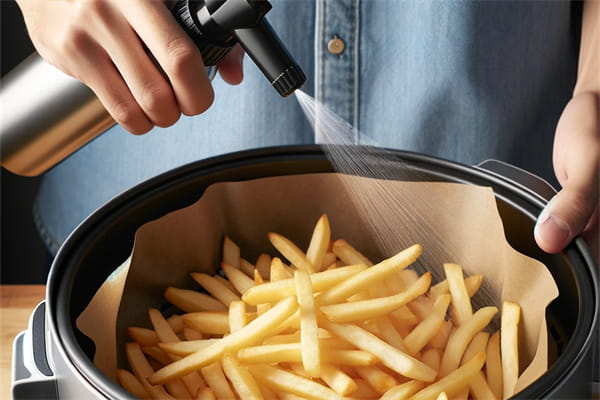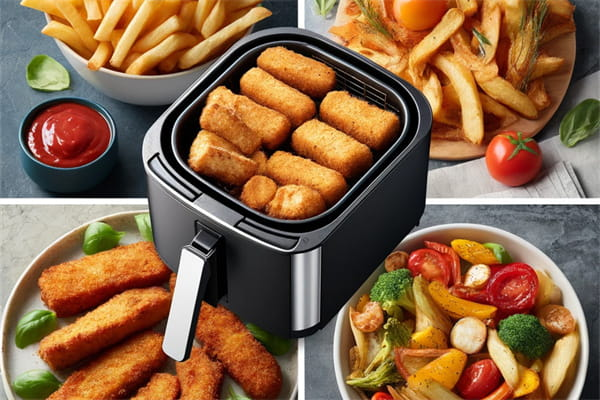When it comes to air fryers, many of us are unsure about one thing: the use of oil. Do air fryers need oil? What types of oil can be used in an air fryer? These are common questions you might have had, and I’ll answer them below. Here’s everything you need to know about using oil in an air fryer.
Ⅰ. Do You Need Oil in an Air Fryer?
Yes, sometimes an air fryer does require some oil, but not always. In certain cases, using a small amount of oil can help prevent food from sticking and can also enhance the texture and flavor of your dishes. Simply use an oil sprayer or brush to apply a thin layer of oil to your food. This is particularly useful for foods that tend to dry out or lack natural fat content.
For example, if you are making homemade French fries or breaded chicken tenders, a light mist of oil can make a significant difference in the crispiness and taste. However, for naturally fatty foods like chicken wings or bacon, you might not need to add any extra oil at all. The key is moderation – just enough to coat the food without making it greasy.

Ⅱ. Where to Put Oil in an Air Fryer
Understanding where to put the oil in an air fryer is crucial for optimal results. Unlike traditional deep fryers where food is submerged in oil, air fryers use hot air to cook food with minimal oil.
You should apply oil directly to the food rather than adding it to the air fryer basket or base. Using an oil sprayer or a brush, lightly coat the surface of the food. This ensures that the food gets an even distribution of oil, which helps in achieving a uniform golden-brown finish. Avoid pouring oil directly into the basket or onto the heating elements, as this can cause smoke and potentially damage your air fryer.
Ⅲ. How to Use Oil in an Air Fryer
Using oil correctly can enhance the taste and texture of your food. Here are some simple steps to ensure you’re using oil properly in your air fryer:
1.Preheat Your Air Fryer:
Just like with an oven, preheating your air fryer can lead to better cooking results. It allows the food to start cooking immediately upon being placed inside.
2.Dry Your Food:
Before applying oil, make sure your food is dry. Moisture can prevent oil from sticking properly and may result in uneven cooking.
3.Apply Oil:
Use a spray bottle or brush to apply a thin, even layer of oil to the food. This helps in achieving a crispy texture without using too much oil.
4.Shake or Flip:
If you’re cooking a larger batch or pieces of food that overlap, shake the basket halfway through cooking or flip the food to ensure even cooking and oil distribution.
Ⅳ. Foods That Require Oil in an Air Fryer
Some foods benefit significantly from a light coating of oil. Here are a few examples:
French Fries: A small amount of oil can make homemade fries crispier and more golden.
Breaded Chicken: Oil helps the breading adhere and get that desired crunchy texture.
Vegetables: A light mist of oil can enhance the flavor and prevent vegetables from drying out.
Tofu: Oil helps tofu crisp up on the outside while remaining tender inside.
These foods typically have low natural fat content or need a little oil to enhance their texture and taste, resulting in a product that is similar to traditional frying but with fewer calories and less fat.

Ⅴ. How Much Oil Should You Use in an Air Fryer?
It’s important to know the right amount of oil to use. Generally, you only need about one to two teaspoons of oil for most air fryer recipes. This small amount can be distributed evenly using an oil sprayer.
Using too much oil can cause excess smoke and may even result in greasy food, defeating the purpose of using an air fryer. Conversely, using too little oil might not give you the crispiness you desire. Finding the right balance is key.
Ⅵ. Types of Oil You Can Use in an Air Fryer
Not all oils are suitable for air frying. Here are some recommended oils along with their smoke points:
Olive Oil: With a smoke point of around 375°F (190°C), olive oil is great for its flavor and health benefits. It’s suitable for moderate-temperature air frying.
Avocado Oil: This oil has a high smoke point of about 520°F (271°C), making it ideal for high-temperature air frying.
Canola Oil: With a smoke point of around 400°F (204°C), canola oil is a neutral-flavored oil that is suitable for most air fryer recipes.
Coconut Oil: This oil has a smoke point of approximately 350°F (177°C), adding a subtle flavor and being good for medium-temperature cooking.
Understanding the smoke points of different oils is crucial. Oils with higher smoke points are better suited for air frying because they won’t burn or smoke at higher temperatures, ensuring a safe and pleasant cooking experience.
Ⅶ. Important Tips for Using Oil in an Air Fryer
Follow these tips for the best results when using oil in your air fryer:
Use a High-Quality Oil Sprayer: This helps in applying a fine, even mist of oil.
Avoid Aerosol Cooking Sprays: These can contain additives that might damage the non-stick coating of your air fryer basket.
Store Oils Properly: Keep oils in a cool, dark place to maintain their quality and extend their shelf life.
Clean Your Air Fryer Regularly: This prevents oil buildup and keeps your air fryer in good condition.
Ⅷ. Conclusion
Using oil in an air fryer can enhance your cooking experience if done correctly. From knowing when and where to apply oil, to choosing the right type and amount, these guidelines will help you achieve delicious, crispy results every time. Enjoy the benefits of your air fryer with these essential oil usage tips and transform your cooking today.